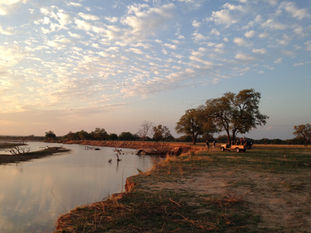
Conservation Biology
Group

Transforming Conservation: A New Framework for Sustainable Natural Resource Management
Dec 2, 2024
3 min read
0
12
0
Bridging Justice, Power and Sustainability
In a world facing rapid biodiversity loss and a worsening climate crisis, the need for sustainable resource use is more urgent than ever. A recent article published by Jacqueline Loos (et. al 2024)1 sheds light on how conservation and development interventions (CDIs) can better drive transformative change by addressing the interlinked areas of equity, power, and sustainability.
The Three Realms of Intervention
For a better understanding the authors categorized CDIs into three distinct realms based on their strategies for achieving transformative change. Each realm represents a different aspect of how values, rules, knowledge systems, power relations and environmental justice interact in driving sustainability.

Fig.1: Visualization depicting the three interconnected realms influencing the transformative capacity of conservation and development initiatives (CDIs). These realms encompass power dynamics, decision-making processes, and considerations of environmental justice.
The Management Realm:
This real addresses the visible aspects of power structures, focusing on formal rules and distributive justice. The revision of legal frameworks to ensure equitable sharing of resources between stakeholders, for example, falls within this category. While limiting CDI to this area is effective in the short term, it risks perpetuating dominant narratives and excluding marginalized voices2,3.
The Engagement Realm:
Procedural justice is the focus here and aims to include all stakeholders in decision-making processes. By addressing hidden power structures such as exclusionary norms and practices, this realm fosterscollaboration and democratization4. However, it requires adaptive, context-specific strategies to ensure long-term success.
The Understanding Realm:
The most profound and challenging realm delves into recognitional justice and invisible power dynamics. This involves questioning established ideologies and promoting an inclusive understanding of values, knowledge systems and rights4. By changing societal narratives, this realm sets the foundation for lasting systemic change.
Power Dynamics in Conservation:
The Paper highlights how visible, hidden, and invisible power dynamics influence CDIs. From top-down decision-making to implicit societal biases, power imbalances often marginalize vulnerable communities5,6. Addressing these dynamics is essential for fostering equitable and effective conservation practices.
Justice at the Core:
Central to the paper’s framework are the dimensions of environmental justice5,6:
Distributive Justice: Ensuring fair allocation of resources and benefits.
Procedural Justice: Empowering diverse voices in decision-making.
Recognitional Justice: Respecting and valuing all stakeholders’ identities, knowledge, and rights.
By integrating these dimensions, CDIs can navigate the complexities of resource governance while advancing both ecological and social well-being1.
Towards a Transformative Future
This article underscores the importance of a holistic, justice-oriented approach to conservation. Short-term interventions may address immediate issues, but achieving lasting change requires deep engagement with societal values, knowledge systems, and power structures. CDIs must move beyond surface-level management to foster inclusive, systemic transformations1.
As we confront the intertwined challenges of biodiversity loss and social inequities, the insights from this research offer a roadmap for reimagining conservation. By placing justice and equity at the heart of our efforts, we can build a sustainable future that benefits both people and the planet1.
References
Loos, J., Cortés-Capano, G., Riechers, M., Walsh, C. & Leventon, J. Enhancing the transformative potential of interventions for the sustainable use of natural resources. Biological Conservation vol. 296 (2024).
Pullen, A. & Rhodes, C. Corporeal ethics and the politics of resistance in organizations. Organization 21, 782–796 (2014).
Weber, K. & Glynn, M. A. Making Sense with Institutions: Context, Thought and Action in Karl Weick’s Theory. Organ. Stud. 27, 1639–1660 (2006).
Gaventa J. Finding the space for change: a power analysis. IDS Bull 37, 23–3 (2006).
Martin, A., Coolsaet, B., Corbera, E., Dawson, N. M., Frases, J. A., Lehmann, I., Rodriguez, I. Justice and conservation: The need to incorporate recognition. Biological Conservation vol. 197 254–261 (2016).
Schlosberg, D. Climate Justice and Capabilities: A Framework for Adaptation Policy. Ethics Int. Aff. 26, 445–461 (2012).





